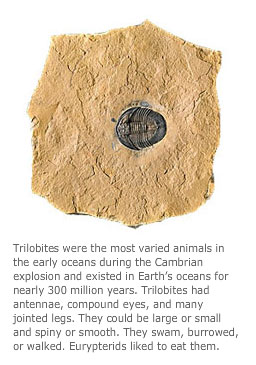Oxygen Boom!
Between 700-550 million years ago, in the late Proterozoic, oxygen levels in the oceans and atmosphere increased dramatically. By 600 million years ago, the oxygen in the atmosphere reached about one-fifth of today’s level (21 percent). The oxygen boom favored the evolution of lifeforms that could use oxygen to create energy. For other organisms, oxygen was poisonous, and they were forced into extreme airless habitats or into extinction. Some scientists say that the increase in oxygen helped fuel the burst of sea life known as the Cambrian explosion, 530 to 509 million years ago, including the evolution of eurypterids and trilobites.
Until about 430 million years ago, most aerobic organisms lived in the ocean and used oxygen dissolved in seawater. Then about 430 million years ago, life on land appeared. Small plants and invertebrates (animals without backbones) evolved the ability to live on land and use oxygen directly from the atmosphere. During the Devonian Period, 416-397 million years ago, plants evolved, as did the first four-footed animals.
Forecast:
Warmer followed by CoolerAs the atmosphere changed, so did Earth’s temperatures. At the beginning of the Devonian Period, the world was warm. More plants and soil reduced the amount of carbon dioxide in the atmosphere-the Earth grew cooler.

